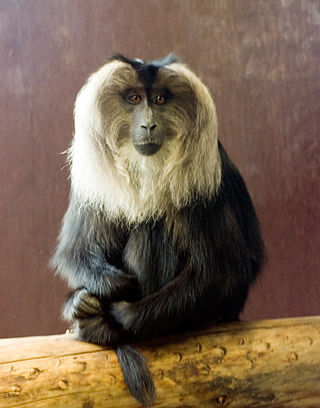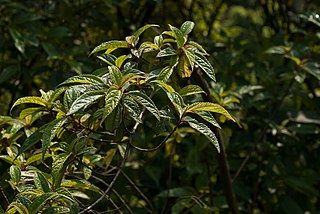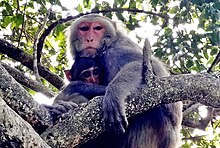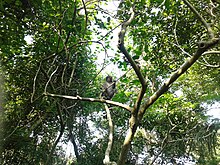
The macaques constitute a genus (Macaca) of gregarious Old World monkeys of the subfamily Cercopithecinae. The 23 species of macaques inhabit ranges throughout Asia, North Africa, and Europe. Macaques are principally frugivorous, although their diet also includes seeds, leaves, flowers, and tree bark. Some species such as the long-tailed macaque will supplement their diets with small amounts of meat from shellfish, insects, and small mammals. On average, a southern pig-tailed macaque in Malaysia eats about 70 large rats each year. All macaque social groups are arranged around dominant matriarchs.

The crab-eating macaque, also known as the long-tailed macaque and referred to as the cynomolgus monkey in laboratories, is a cercopithecine primate native to Southeast Asia. A species of macaque, the crab-eating macaque has a long history alongside humans. The species has been variously seen as an agricultural pest, a sacred animal, and, more recently, the subject of medical experiments.

The rhesus macaque, colloquially rhesus monkey, is a species of Old World monkey. There are between six and nine recognised subspecies that are split between two groups, the Chinese-derived and the Indian-derived. Generally brown or grey in colour, it is 47–53 cm (19–21 in) in length with a 20.7–22.9 cm (8.1–9.0 in) tail and weighs 5.3–7.7 kg (12–17 lb). It is native to South, Central, and Southeast Asia and has the widest geographic range of all non-human primates, occupying a great diversity of altitudes and a great variety of habitats, from grasslands to arid and forested areas, but also close to human settlements. Feral colonies are found in the United States, thought to be either released by humans or escapees after hurricanes destroyed zoo and wildlife park facilities.

The Barbary macaque, also known as Barbary ape, is a macaque species native to the Atlas Mountains of Algeria, Tunisia and Morocco, along with a small introduced population in Gibraltar. It is the type species of the genus Macaca. The species is of particular interest because males play an atypical role in rearing young. Because of uncertain paternity, males are integral to raising all infants. Generally, Barbary macaques of both sexes and all ages contribute in alloparental care of young.

The Japanese macaque, also known as the snow monkey, is a terrestrial Old World monkey species that is native to Japan. Colloquially, they are referred to as "snow monkeys" because some live in areas where snow covers the ground for months each year – no other non-human primate lives farther north, nor in a colder climate. Individuals have brownish grey fur, pinkish-red faces, and short tails. Two subspecies are known.

The Moor macaque is a macaque monkey with brown/black body fur with a pale rump patch and pink bare skin on the rump. It has ischial callosities, which are oval-shaped. It is about 50–58.5 cm long, and eats figs, bamboo seeds, buds, sprouts, invertebrates and cereals in tropical rainforests. It is sometimes called "dog-ape" because of its dog-like muzzle, although it is no more closely related to apes than any other Old World monkey is. It is endemic to the island of Sulawesi in Indonesia, which is an important biodiversity hotspot.

The Formosan clouded leopard is a clouded leopard population that was endemic to Taiwan. Camera trapping studies carried out in several protected areas in Taiwan between 1997 and 2012 did not record any clouded leopard. The population is listed as extinct on the IUCN Red List.

The lion-tailed macaque, also known as the wanderoo, is an Old World monkey endemic to the Western Ghats of South India.

The Celebes crested macaque, also known as the crested black macaque, Sulawesi crested macaque, or the black ape, is an Old World monkey that lives in the Tangkoko reserve in the north-eastern tip of the Indonesian island of Sulawesi (Celebes), as well as on smaller neighbouring islands.

The toque macaque is a reddish-brown-coloured Old World monkey endemic to Sri Lanka, where it is known as the rilewa or rilawa, . Its name refers to the whorl of hair at the crown of the head, reminiscent of a brimless toque cap.

The bonnet macaque, also known as zati, is a species of macaque endemic to southern India. Its distribution is limited by the Indian Ocean on three sides and the Godavari and Tapti Rivers, along with its related competitor the rhesus macaque in the north. Land use changes in the last few decades have resulted in changes in its distribution boundaries with the rhesus macaque, raising concern for its status in the wild.

The stump-tailed macaque, also called the bear macaque, is a species of macaque native to South Asia and Southeast Asia. In India, it occurs south of the Brahmaputra River, in the northeastern part of the country. Its range in India extends from Assam and Meghalaya to eastern Arunachal Pradesh, Nagaland, Manipur, Mizoram and Tripura.

The northern pig-tailed macaque is a vulnerable species of macaque in the subfamily Cercopithecidae. It is found in Bangladesh, Cambodia, China, India, Laos, Myanmar, Thailand, and Vietnam. Traditionally, M. leonina was considered a subspecies of the southern pig-tailed macaque, but is now classified as an individual species. In the 21st century, the pig-tailed macaque was split into the northern pig-tailed macaque species Macaca leonina and the Sundaland pig-tailed macaque species M. nemestrina. This reclassification was aided by the observation of sexual swellings and basic attributes that distinguish the two. The northern pig-tailed macaque is frugivorous and their social grouping is matriarchal, where sexual dimorphic traits can distinguish males and females. Their adaptation to omnivorous diets occur in periods of fruit scarcity, munching on wild vegetation and crops, human foods, and small insects and mammals. Despite their adaptability, northern-pig tailed macaques experience viral threats such as the human immunodeficiency virus type 1, pathogenic simian immunodeficiency, and coronavirus. Human impacts are also present, such as agricultural expansions, aquaculture, transportation infrastructure, hunting and logging for meat and trophies, and the illegal pet trade; that result in habitat loss, forest fragmentation, and a reduced well-being.

The Tonkean black macaque or Tonkean macaque is a species of primate in the family Cercopithecidae. It is endemic to central Sulawesi and the nearby Togian Islands in Indonesia. It is threatened by habitat loss. Widespread mining in central Sulawesi is believed to exacerbating the problems of habitat loss.
Hepatocystis is a genus of parasites transmitted by midges of the genus Culicoides. Hosts include Old World primates, bats, hippopotamus and squirrels. This genus is not found in the New World. The genus was erected by Levaditi and Schoen, 1932, as Hepatocystes.
Hepatocystis taiwanensis is a species of parasitic protozoa. They are transmitted by flies of the genus Culicoides and infect monkeys.
Prunus phaeosticta, the dark-spotted cherry, is a species of Prunus native to China, including Taiwan, and southeast Asia, including far eastern India, Bangladesh, Burma, Thailand, Laos and Vietnam. It goes by a number of different names in Chinese, including 黑星櫻, black star cherry, 墨點櫻桃 and 墨点樱桃, ink point cherry, and 腺葉桂櫻, gland leaf cherry. It gets its specific epithet and its common names from the small dark spots (glands) on the undersides of its leaves. Formosan rock macaques eat the fruit.

The Formosan ferret-badger is a mustelid species endemic to Taiwan.

Oreocnide pedunculata, the purple woodnettle or longpedicel woodnettle, is a species of flowering plant in the family Urticaceae, native to south-central and southern Japan, the Ryukyu Islands, and Taiwan. A shrub or small tree 2 to 5 m tall, it is found growing in valleys and forest edges at elevations from 100 to 1,200 m. Its leaves are an important food item for Formosan rock macaques and Japanese macaques.


















